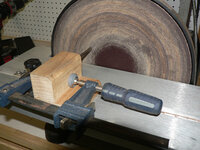medemt
Member
I have finally got the courage to step up to some of the larger pen kits. Working with the slimlines and a few other 7mm pens, the barrel trimmer was pretty much a no brainer (however I did have a few dymondwood blanks destroyed).
Being fairly new to all this, I went out and bought a bunch of kits that use some very large bits/tubes, and as I pondered over how I was going to at least make a good effort at turning them, it dawned on me that I did not have the means (knowledge) of how I was going to trim the blanks.
If anyone would be willing to show some pictures of their jigs, methods, etc. I sure would appreciate it. I do have a disk sander and I am open to that, but was also interested in other ideas. I like to try all kinds of methods so I can see what best works for me.
If there are posts or tutorials out there that deal with this very well, could you point me in the right direction.
As always, I appreciate all of you that are willing to help the new (inexperienced) guys.
Dan
Being fairly new to all this, I went out and bought a bunch of kits that use some very large bits/tubes, and as I pondered over how I was going to at least make a good effort at turning them, it dawned on me that I did not have the means (knowledge) of how I was going to trim the blanks.
If anyone would be willing to show some pictures of their jigs, methods, etc. I sure would appreciate it. I do have a disk sander and I am open to that, but was also interested in other ideas. I like to try all kinds of methods so I can see what best works for me.
If there are posts or tutorials out there that deal with this very well, could you point me in the right direction.
As always, I appreciate all of you that are willing to help the new (inexperienced) guys.
Dan

